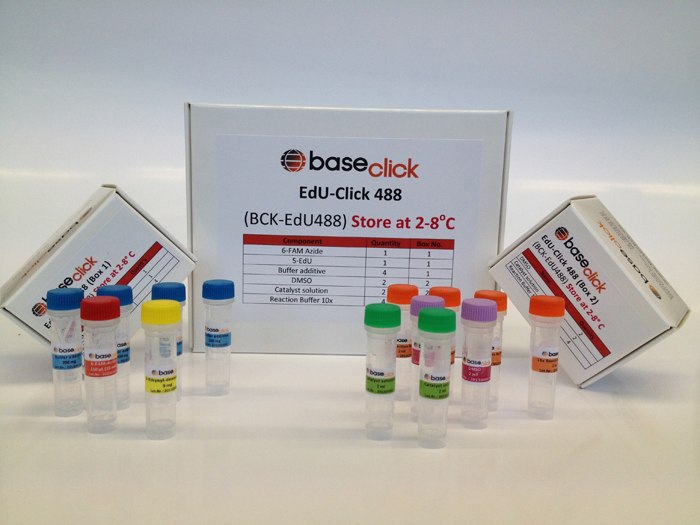Baseclick EdU Cell Proliferation Detection Kits: Improve Data Quality and Save Time

Introduction
Experimental studies measuring cell proliferation have had implications in cancer biology, immunology, cell biology, and developmental biology. Various methods for monitoring cell proliferation have been developed. Counting cells using a hemocytometer is one of the simplest methods used to monitor cultured cell growth, but researchers are limited by the number of samples they can process. For high throughput screening, colorimetric plate-based formats are commonly used on cultured cells. Two popular colorimetric methods are SRB assays in which the sulforhodamine B dye is used to stain for protein content and MTT assays in which the tetrazolium dye is reduced by mitochondrial enzymes to a formazin product. Both methods produce a signal that correlates with the number of cells, but are not specific for proliferating cells.1 Immunostaining of proliferation-associated antigens, such as PCNA and Ki67, has been used to detect proliferation in tissues; however, this only reports on cells that are proliferating at the time when the tissue is collected and may not reflect cells proliferating during a defined time period.2
Monitoring active DNA-synthesis in cells is the best indicator of proliferation. Specific detection of DNA replication over a period of time can be measured by incorporating modified nucleosides, such as 3H-Thymidine, in which the radioactivity is detected. To avoid radioactivity, the anti-bromodeoxyuridine (BrdU) assay was developed in which the modified nucleoside BrdU is incorporated into DNA and subsequently detected using an antibody.3 Sigma-Aldrich now offers Baseclick kits to monitor DNA replication. These kits measure cell proliferation by detecting the incorporation of the alkyne-modified nucleoside EdU (5-Ethynyl-2′-deoxyuridine) into DNA using copper-catalyzed azide-alkyne click chemistry to attach fluorescent probes.
Advantages
Salic and Mitcheson first reported on EdU incorporation and demonstrated the technique offered improvement over the BrdU method.4 For example, EdU incorporation and detection does not require DNA denaturation leading to fewer steps and reduced degradation of tissues. Additionally, Sigma-Aldrich’s Baseclick kits take advantage of efficient reaction times afforded by azide-alkyne copper click chemistry, which can be complete in 30 minutes. Baseclick kits are convenient and can save researchers valuable time with assay times of about 1 ½ hours. Because of these benefits, EdU incorporation is preferred for monitoring cell proliferation when compared to BrdU.2,3
Representative Applications
Baseclick has developed different EdU kits for microscopy imaging, flow cytometry, and high throughput screening. Each kit comes with an optimized experimental protocol and the required components for each application. EdU incorporation can be visualized using the microscopy imaging kits. The flow cytometry kits allow researchers to obtain quantitative detection of the labeled cells. The high throughput kits have been optimized for measurements using a plate reader. Also, individual cells can be studied using an automated microscope or high content imaging system for reviewing cell morphology.

In vivo kits have been developed that include larger amounts of EdU and include one of the three above mentioned kits, depending on the desired endpoint detection method. So far, EdU has been incorporated into the following model organisms: mouse, rat, C. elegans, cricket, chicken, zebra fish larva, and Arabidopsis.4,5,6,7,8,9,10
Baseclick kits utilize fluorescent probes to detect the incorporated EdU. Researchers can choose from four fluorescent probes: 6-FAM (ex: 496 nm, em: 516 nm), 5-TAMRA (ex: 546 nm, em: 579 nm), 5/6-Sulforhodamine 101 (ex: 584 nm, em: 603 nm) and Eterneon-Red 645 (ex: 643 nm, em: 662 nm). These probes can be multiplexed with other fluorescent probes including using antibodies for immunostaining, expanding experimental options.
Materials
References
To continue reading please sign in or create an account.
Don't Have An Account?